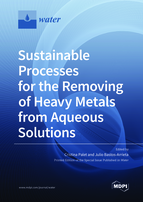Sustainable Processes for the Removing of Heavy Metals from Aqueous Solutions
A special issue of Water (ISSN 2073-4441). This special issue belongs to the section "Wastewater Treatment and Reuse".
Deadline for manuscript submissions: closed (30 November 2022) | Viewed by 37155
Special Issue Editors
Interests: separation science; analytical chemistry; membrane technologies; environmental science; green chemistry; materials science; nanosystems; water treatment
Special Issues, Collections and Topics in MDPI journals
2. Institut de Recerca de l’Aigua (IdRA), University of Barcelona, Barcelona, Spain
Interests: nanomaterials; surface science; water treatment; green chemistry; characterization techniques; material science
Special Issues, Collections and Topics in MDPI journals
Special Issue Information
Dear Colleagues,
Water pollution is a global problem threatening the entire biosphere and affecting the life of many millions of people. It is not only one of the foremost global risk factors for illness, diseases and death, as it also contributes to the continuous reduction of the available drinkable water sources worldwide. Delivering valuable solutions, which are easy to implement and affordable, often remains a challenge.
Heavy metal ions are some of the most harmful and widespread contaminants, with adverse effects to the environment. Actually, they are one of deadly contaminants in ground water across the globe. Biosorption of heavy metals by metabolically inactive non-living biomass of microbial or plant origin is an innovative and alternative technology for removal of these pollutants from aqueous solution.
This Special Issue attempts to summarize the state-of-the-art of current macro-, micro- and nanotechnologies for water purification, discussing their field of application specially for heavy metal ion removal.
For instance, this Special Issue aims to present the recently available information on utilizing different biomass materials for heavy metals removal, highlighting the increasing use of these materials due to their low cost, regeneration ability, high adsorption efficiency, and small chemical or biological sludge with a possibility of metal recovery.
Furthermore, the selected contributions will be considered from the technology used in each case, and in the context of their sustainability. One important purpose of this Special Issue is to ensure the possible implementation in real applications of technologic tools developed under interesting research funded projects. So, this Special Issue will mainly focus on sustainable efficient approaches, that provide innovation and ease to implementation.
Dr. Cristina Palet
Dr. Julio Bastos-Arrieta
Guest Editors
Manuscript Submission Information
Manuscripts should be submitted online at www.mdpi.com by registering and logging in to this website. Once you are registered, click here to go to the submission form. Manuscripts can be submitted until the deadline. All submissions that pass pre-check are peer-reviewed. Accepted papers will be published continuously in the journal (as soon as accepted) and will be listed together on the special issue website. Research articles, review articles as well as short communications are invited. For planned papers, a title and short abstract (about 100 words) can be sent to the Editorial Office for announcement on this website.
Submitted manuscripts should not have been published previously, nor be under consideration for publication elsewhere (except conference proceedings papers). All manuscripts are thoroughly refereed through a single-blind peer-review process. A guide for authors and other relevant information for submission of manuscripts is available on the Instructions for Authors page. Water is an international peer-reviewed open access semimonthly journal published by MDPI.
Please visit the Instructions for Authors page before submitting a manuscript. The Article Processing Charge (APC) for publication in this open access journal is 2600 CHF (Swiss Francs). Submitted papers should be well formatted and use good English. Authors may use MDPI's English editing service prior to publication or during author revisions.
Keywords
- Water treatment
- Heavy metals
- Biomass
- Biosorption
- Remediation
- Nanotechnology







